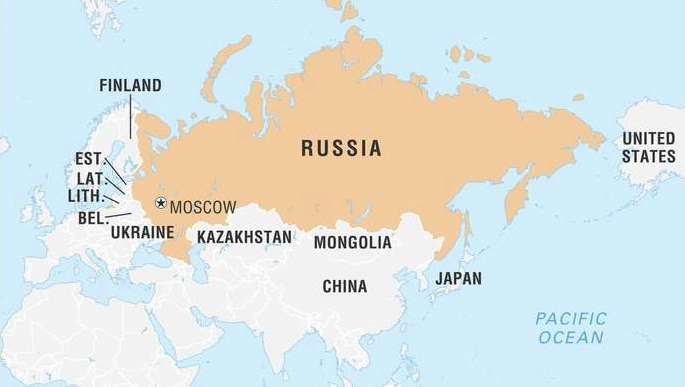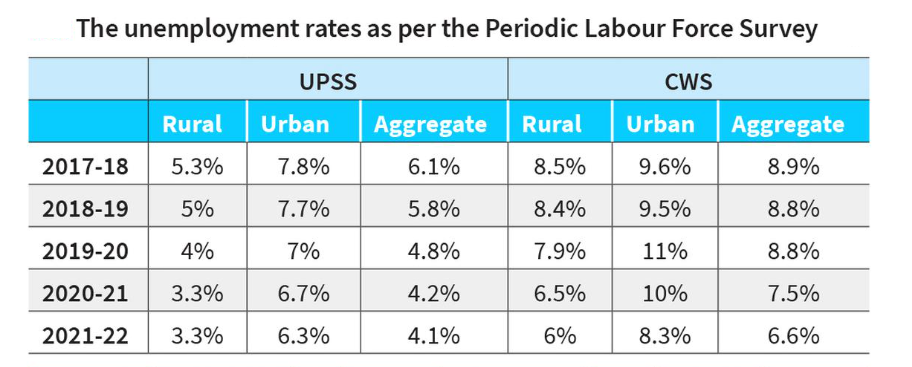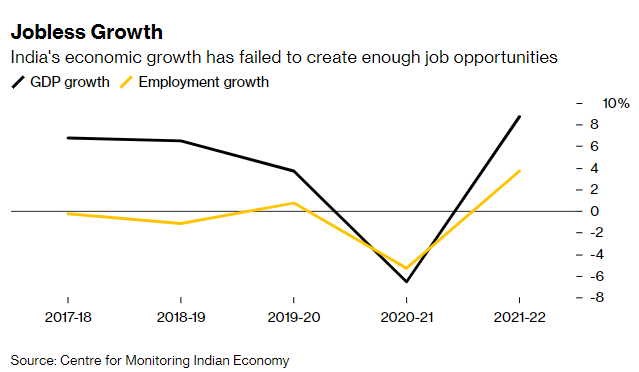CONTENTS
- India-Russia Ties in a Changed World
- India’s Jobs Crisis- the Macroeconomic Reasons
India-Russia Ties in a Changed World
Context:
The significance of the visit by External Affairs of India to Russia this week is underscored by the concerted effort made by New Delhi and Moscow to ensure the success and productivity of the meetings. This extended five-day visit holds particular weight for India, especially considering the culmination of a year marked by active diplomacy.
Relevance:
GS2- International Relations- Bilateral, Regional and Global Groupings and Agreements involving India and/or affecting India’s interests.
Mains Question:
The recent visit of the Indian External Affairs Minister to Russia signifies that India and Russia seem keen on renewing ties in a changed world. Comment. (15 Marks, 250 Words).
Indo- Russia Relations:

Historical Context:
- The longstanding relationship between India and Russia has been defined by the “Declaration on the India-Russia Strategic Partnership,” signed in October 2000.
- Since then, the ties have evolved significantly, encompassing various areas such as political, security, defense, trade, economy, science and technology, and culture.
- During the Cold War, India and the Soviet Union maintained a robust strategic, military, economic, and diplomatic alliance.
- Following the dissolution of the Soviet Union, Russia inherited this close association with India, leading to the development of a Special Strategic Relationship between the two nations.
Political Relations:
- In 2019, President Putin awarded PM Narendra Modi Russia’s highest state decoration – The Order of St Andrew the Apostle – recognizing his distinguished contribution to the development of the privileged strategic partnership between Russia and India.
- Two Inter-Governmental Commissions – one on Trade, Economic, Scientific, Technological and Cultural Cooperation (IRIGC-TEC), and another on Military-Technical Cooperation (IRIGC-MTC) – convene annually.
Trade Relations:
- Both nations aspire to increase bilateral investment to US$50 billion and bilateral trade to US$30 billion by 2025. In FY 2020, bilateral trade amounted to USD 8.1 billion.
- After a decline from 2013 to 2016, trade between the two countries showed a consistent increase from 2017 onwards, continuing through 2018 and 2019.
Defence and Security Relations:
- India-Russia military-technical cooperation has progressed from a buyer-seller framework to joint research, development, and production of advanced defense technologies and systems. Regular Tri-Services exercises, such as ‘INDRA,’ are conducted.
- Joint military programs include the BrahMos cruise missile program, 5th generation fighter jet program, Sukhoi Su-30MKI program, Ilyushin/HAL Tactical Transport Aircraft, KA-226T twin-engine utility helicopters, and certain frigates.
- India has acquired military hardware from Russia, including the S-400 Triumf, Kamov Ka-226 under the Make in India initiative, T-90S Bhishma, INS Vikramaditya aircraft carrier, and various submarines.
- Russia plays a crucial role in supporting India’s submarine programs, and a significant portion of India’s conventional submarines is of Russian origin.
Significance of the Recent Meet:
- The duration is noteworthy, especially since the Kremlin typically avoids high-level foreign visits in the period just before its holiday season.
- Additionally, it is uncommon for Russian President Vladimir Putin to engage with lower-ranking foreign officials, as observed in his meeting with Mr. Jaishankar.
- The warmth of the interaction carries significance, especially in light of Prime Minister Narendra Modi’s absence from the annual leadership summit for the past two years, breaking a tradition dating back to 2000-21. This has led to speculation about the state of the India-Russia relationship post the Ukraine war.
Outcomes of the Meet:
- The resulting agreements of the meet, focusing on enhancing collaboration in upcoming Kudankulam nuclear power projects, promoting connectivity and trade, resuming discussions for the Eurasian Economic Union-India free trade agreement, and joint military production, indicate that bilateral relations are moving in a positive direction.
- It is evident that a significant aspect of Mr. Jaishankar’s mission was to address and alleviate the perceived differences.
- This is also reflected in the realm of multilateral cooperation, particularly as Russia plans to host the expanded BRICS summit next year, and India and Russia continue to align their positions at the UN and SCO.
- Mr. Jaishankar’s announcement that imports of Russian hydrocarbons will increase despite Western sanctions on Russia underscores the resilience of the ties that persist “regardless of political fluctuations.”
- Mr. Jaishankar’s confirmation that the annual leadership summit will be reinstated in 2024 seems to indicate a joint effort to resolve any issues in the relationship.
- His assertion that the India-Russia relationship has been the ‘only constant in world politics’ over the past six decades would likely have caught the attention of Washington and Beijing.
Challenges in India- Russia Relations:
- While refraining from overtly criticizing Russia, concerns persist regarding the decline in defense supplies, ongoing challenges in paying Russia for imports using third currencies, and a general decrease in other bilateral engagements for India.
- This is especially significant given some tensions in India-U.S. relations regarding the Pannun investigation and President Joseph Biden’s decision to decline Mr. Modi’s Republic Day invitation.
- Meanwhile, India-China relations remain at an impasse over the military standoff. The extent to which this camaraderie will lead to tangible progress on the rupee-rouble payment mechanism or the expedited delivery of S-400 air system units remains to be seen.
Conclusion:
Nevertheless, the broader significance of his visit, particularly his mention of the “geopolitical and strategic convergence” between India and Russia in a rebalancing multipolar world, will be closely observed by both advocates and critics of the relationship.
India’s Jobs Crisis- the Macroeconomic Reasons
Context:
There are numerous signs indicating that India is currently grappling with a significant employment crisis. Both official data sources and numerous firsthand reports on the ground confirm this reality. There is a need to discuss in detail the macroeconomic factors contributing to this crisis.
Relevance:
GS2- Indian Economy- Indian Economy and issues relating to Planning, Mobilization of Resources, Growth, Development and Employment.
Mains Question:
Providing details on the current employment crisis in India, analyse how macroeconomic factors contribute to this crisis. (10 Marks, 150 Words).
Fundamentals of Employment in India:
To begin with, it is helpful to differentiate between the two main forms of employment prevalent in economies like India.
Wage Employment and Self Employment:
- The first type is wage employment, resulting from employers seeking labor for profit.
- The second is self-employment, where labor supply and demand are synonymous, meaning the worker employs themselves.
Wage Labor and Jobs:
- Additionally, it is beneficial to distinguish between wage labor and jobs.
- The former encompasses all forms of labor done for an employer, ranging from daily wage work to highly paid corporate positions.
- Conversely, jobs generally refer to relatively well-compensated regular wage or salaried employment. In essence, all jobs are a form of wage labor, but not all wage labor qualifies as jobs.
- Throughout its history, the Indian economy has featured both open unemployment (job-seekers without work) and substantial levels of informal employment, encompassing the self-employed and casual wage workers.
Unemployment in India:

Current State of Unemployment in India based on the “State of Working India 2023″ Report:
Unemployment Rate:
The overall unemployment rate has seen a decrease from 8.7 percent in 2017-18 to 6.6 percent in 2021-22.
Unemployment by Education and Age:
In 2021-22, over 42 percent of India’s graduates under the age of 25 were unemployed. For those who have completed higher secondary education in the same age group, the unemployment rate stands at 21.4 percent.
Women’s Employment Situation:
- Following the COVID-19 pandemic, 60 percent of women are self-employed, compared to 50 percent before the pandemic.
- However, women’s earnings have decreased, with their 2022 earnings being only 85 percent of what they were before the pandemic.
Inter-generational Employment Mobility:
- There has been inter-generational mobility in casual labor, with a higher number of individuals from general castes transitioning out of casual labor compared to SCs/STs.
- In 2021, 40 percent of SC workers were engaged in casual employment, while only 13 percent of general caste workers were.
- Additionally, around 22 percent of SC workers were regular wage workers, contrasting with 32 percent of general caste workers.
Nature of Economic Growth:
- Economic growth in India has not translated into increased employment opportunities.
- The capacity to generate formal sector jobs has consistently declined with each percentage increase in GDP.
- Despite workers moving out of the agricultural sector, they have predominantly been absorbed into informal and contractual employment rather than formal employment
Macroeconomic Factors:
Labor in the Formal Non-Agricultural Sector:
- The demand for labor in the formal non-agricultural sector is influenced by two distinct factors.
- Firstly, as formal sector firms employ workers to generate output for profit, labor demand is contingent on the quantity of output these firms can sell. Given a constant level of technological development, labor demand in the formal sector increases with the rise in demand for output.
- Secondly, labor demand is influenced by the state of technology, which determines the number of workers firms need to hire to produce one unit of output. The introduction of labor-saving technologies allows firms to produce the same output with a reduced number of workers.
Employment Growth Rate and GDP:
- As economic policy is typically framed in terms of output growth (such as GDP or value-added), rather than the absolute level of output, let’s analyze this argument in the context of growth rates.
- The employment growth rate is determined by the relative strength of two factors: the output growth rate and the labor productivity growth rate (the growth rate of output per worker).
- If the labor productivity growth rate remains constant, a higher output growth rate results in an increased employment growth rate.
- In other words, policies promoting higher economic growth would also lead to higher employment growth. Conversely, if the labor productivity growth rate rises, the employment growth rate falls for a given output growth rate.
- In India, despite a significant increase in GDP growth rate and value-added growth rate during the 2000s compared to the decades of the 1980s and 1990s, the employment growth rate in the formal non-agricultural sector remained unresponsive.
- This lack of responsiveness indicates a phenomenon of jobless growth, highlighting a strong connection between labor productivity growth rate and output growth rate.
Jobless Growth with Distinctive Indian Features:
- Jobless growth refers to a situation in which the economy is expanding, yet unemployment persists at high levels. In simpler terms, economic growth occurs without a corresponding increase in employment.
- This phenomenon commonly occurs when a significant number of individuals lose their jobs during an economic downturn and struggle to secure new employment even as the economy rebounds.
- As an economy expands, it is commonly observed that it also enhances its productivity. In the course of generating a greater total output, companies typically become more adept at producing additional output per worker, a phenomenon attributed to what economists term “economies of scale.”
- As firms increase their output, they find it more feasible to integrate labor-saving technologies. However, the degree to which these technologies are introduced depends on the bargaining power of labor.

Scenario of Jobless Growth:
- In the first scenario, the correlation between the labor productivity growth rate and the output growth rate is feeble.
- The potential for jobless growth in this case arises primarily due to automation and the adoption of labor-saving technology.
- However, in such scenarios, the employment growth rate would inevitably rise if the output growth rate increases.
- Under weak responsiveness of labor productivity, the positive impact of GDP growth rate on employment would outweigh the negative effect of labor-saving technologies. In this context, the remedy for the jobs crisis lies in achieving more rapid economic growth.
- In the second scenario, exemplified by India, the connection between labor productivity growth rate and output growth rate is robust.
- Here, the favorable impact of output growth rate on employment fails to offset the unfavorable effect of labor-saving technologies.
- In such scenarios, employment growth rate cannot be boosted merely by increasing GDP growth rate.
Macroeconomic Policy Framework in Transition:
- It is generally believed that increasing the output growth rate in the non-agricultural sector would suffice to raise the employment growth rate in the formal sector.
- Contrary to this presumption, evidence suggests that the employment challenge can no longer be adequately addressed solely through accelerated GDP growth. Instead, a distinct policy focus on employment is imperative, complementing the emphasis on GDP growth.
- Effective employment policies require both demand-side and supply-side components. For instance, given the ease with which firms in India can automate due to a shortage of adequately skilled labor, enhancing the workforce’s quality through improved public provision of education and healthcare, along with efforts to bridge the skills gap, becomes crucial. On the demand side, direct public job creation is deemed necessary.
Conclusion:
The financing of expenditures, while ensuring debt stability, demands a significant reorientation of the current macroeconomic framework. This includes augmenting the direct tax-to-GDP ratio by reducing exemptions and enhancing compliance. Additionally, a more imaginative use of macro-policy is advocated to pursue a proactive employment agenda.




